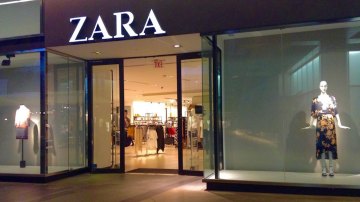The Riccardo Tisci era of Burberry is already taking a different strategic form than Christopher Bailey’s.
During its first quarter financial 2019 earnings call today, the brand announced that it would be backpedaling on the in-season fashion show and collection release strategy it rolled out in spring of 2016, with immediate product release following runway debuts. Instead, Tisci’s first collection for the fashion house will be a spring collection, shown in September and released in February of next year.
In place of immediate runway shows, Burberry is launching a drop model for more frequent capsule collections and collaborations, led by Tisci. There’s no set schedule for the drop collections by Burberry; CFO Julie Brown told investors on Wednesday morning that the result would be more product releases throughout the year, on a “surprise” schedule, taking pressure off of the seasonal runway collections.
“Customers are demanding creativity,” said Brown during the call with investors. “You will see us move toward a fluid, flexible and creatively-led delivery cycle as we deliver unexpected drops of product, content and customer communication.”
By foregoing an in-season model for the drop model, Burberry isn’t entirely giving up on capturing the momentum of the September runway show with a collection release. The first series of Tisci’s instant drops will be clustered around the September 16 event, while a collaboration with designer Vivienne Westwood is scheduled to drop in December.
Amid luxury’s ongoing production calendar crisis, the drop model has emerged as a sort of compromise. It’s a solution that allows for seasonal collection releases to remain on the standard schedule (with runway shows scheduled about six months before the collections featured go on sale), in line with wholesale accounts, while giving brands an opportunity to capitalize on those buzzy moments in other ways, and sell more in between the main seasons. Other fashion houses, like Givenchy, Prada, Alexander Wang and Balenciaga, have begun supplementing their main production calendar with more frequent capsule drops.
The strategy is also a way for brands to gain back control over sales from wholesale accounts. While Brown didn’t specify where September’s drops would be sold, the collaboration with Vivienne Westwood will be sold only in select Burberry and Vivienne Westwood stores and online. Most often, these capsule drops are direct-retail plays.
While releasing more product means selling more overall, the drop model has a business ripple effect. More collections require more content creation and marketing, as well as logistical changes around production. Not to mention, Tisci as creative director will be expending more energy outside of the pillar collections.
“This could lead to burnout for creative directors. You put more pressure on the creative team, not really the sourcing team. They’re forcing the creative to come up with new ideas on a more frequent basis,” said Ed Gribbin, CEO at apparel and retail consultancy Gribbin Strategic.
That’s why collaborations play an increasingly important role in the drop model: They offer an assist to creative heavy lifting, as well as creating buzz. Brown pointed to Burberry’s recent collaboration collection with Beyoncé, the promotion for which saw 1.1 million Instagram Story views and drove Instagram engagement up by 25 percent over the previous quarter. And risks of designer burnout aside, the drop model is a welcome substitute to the logistical challenges of changing production schedules to an in-season calendar.
“To go forward with an immediate fashion calendar, these brands would have to consider an overhaul,” said Caitlin Aylward, director of research at L2. “There are other steps that can be taken to improve speed-to-market, like the drop model – and not to mention, the immediate fashion calendar isn’t something that’s shown it’s worth the effort.”
The drop model, co-opted from the streetwear industry, has also become a hook for the very wholesale retailers that brands are trying to distance themselves from. The Drop @ Barneys, a continuing event series for the department store, invites in streetwear and luxury fashion brands for exclusive collections and product releases over the course of one weekend. Overall, though, retailers will largely miss out on the traffic and sales driven by individual brands following the new strategy. During the call, Brown expressed frustration with buyers that only pick up some of a collection, failing to convey an entire story.
“These small collections are not good for the retail partner,” said Gribbin. “They won’t be getting that product.”
While Burberry ramps up for a series of drops, some in the industry see it as a crutch for a lagging industry working off of tired models.
“Traditional fashion brands’ sales channels are tapped out and boring,” said Ashwin Deshmukh, the director of insights at the digital agency Hungry. “There’s no really great creative coming out of any of the big houses, so they’re using the drop model to create artificial scarcity and regain excitement.”



